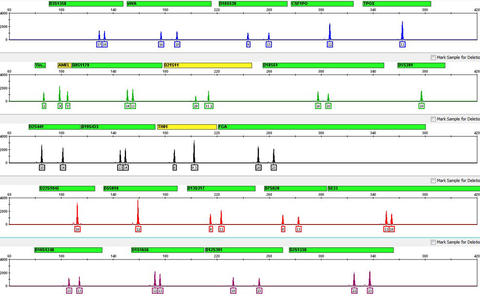
This DNA profile is based on 24 genetic markers (stretches of DNA found at specific locations in the genome). Each genetic marker contains a short tandem repeat (STR)?a section of DNA that repeats itself, like a word typed over and over again, with the number of repeats varying from person to person. In this graph, the peaks represent the number of repeats at each marker. Most markers show two peaks?one inherited from each parent (where only one peak appears in a marker, the individual has inherited the same number of repeats from each parent). These 24 markers produce a series of 48 numbers that can be used to uniquely identify an individual.
In a Hanoi, Vietnam, hotel conference room, Mike Coble led a group of scientists through a series of calculations. Coble's presentation was heavy on the statistics, and this created a lot of work for the translators. It took two of them, working tag-team, to keep up.
Coble is a scientist at the U.S. Department of Commerce's National Institute of Standards and Technology (NIST) and an expert in forensic DNA analysis. Before NIST, he was the research director at the U.S. Armed Forces DNA Identification Laboratory, where he supported U.S. efforts to identify the remains of servicemen killed in Vietnam and other wars.
Today, Vietnam is undertaking a similar effort to identify its war dead, and Coble was in Hanoi this April presenting the latest methods to Vietnamese scientists.
"The U.S. solved a lot of cases," Coble said, including many that became solvable only in the last decade as research led to powerful new techniques for analyzing DNA. "But the Vietnamese are at the beginning of the process."
That process is likely to be a long one. The war left 300,000 Vietnamese unaccounted for, their remains either missing or unidentified. That process will also be a very personal one. "Many of the scientists who participated in the workshop were children during the war, and they and their families experienced it firsthand," Coble said.
For these scientists, the project may have great historical and personal significance, but it is also presents some difficult technical challenges.
Extracting Information from Degraded DNA
For example, scientists create a genetic profile by looking at stretches of DNA that repeat themselves, like the same word typed over and over again. These sections are called short tandem repeats, or STRs, and the number of repeats in each STR varies from person to person.
By measuring the length of several different STRs, forensic analysts generate a series of numbers that are like a code. In the FBI's national DNA database, for instance, a genetic profile is made up of a series of numbers that can be used to identify an individual or vastly narrow the range of suspects.
But in tropical countries such as Vietnam, soils tend to be acidic, which hastens the decomposition of DNA. When that happens, the STRs fall apart like a ribbon cut to pieces, and scientists might only be able to measure a handful of them—not enough to generate a unique genetic profile.
Improved Accuracy in DNA Typing
Coble worked on this problem in the years following the events of 9/11, when investigators had to identify human remains that were exposed to intense heat, which also causes DNA to fragment. Coble and several colleagues at NIST identified miniSTRs—ones so short that they are more likely to remain intact even as the larger DNA fragments around them degrades. This advance allowed scientists to identify remains that would have otherwise been impossible to identify.
Coble discussed miniSTR testing with his Vietnamese counterparts. The technique is useful in many situations. Because they allow for more precise and accurate matching, miniSTRs have also begun to be used in criminal investigations. For instance, three of the miniSTRs identified by NIST scientists in the years after 9/11 will be required when uploading DNA profiles to the FBI's national DNA database starting Jan. 1, 2017.
But for one week in April, Coble stepped away from his research at NIST to share his knowledge. It was his first trip to Vietnam.
Coble's trip was organized by the International Criminal Investigative Training Assistance Program of the U.S. Department of Justice, which helps foreign governments develop professional and transparent law enforcement institutions. That program is funded by the U.S. Agency for International Development, the U.S. Department of State, and the U.S. Department of Defense.
A Shared Language
If it's true that war can dehumanize one's enemies, then perhaps giving fallen enemies a name can humanize them again. If so, Coble's trip, and other efforts like it, are especially fitting gestures of peace between formerly warring nations.
In fact, the assistance that Coble offered the Vietnamese runs in both directions. When U.S. specialists excavate sites in Vietnam to search for the remains of U.S. servicemen, Vietnamese experts participate in the work.
But whatever the deeper meaning of this exchange, Coble said that in the classroom, it was just a bunch of scientists sharing ideas.
"We didn't speak the same language, and we didn't have the same experience in terms of history," Coble noted. "But we were speaking the language of science, and that helped to transcend the differences."

